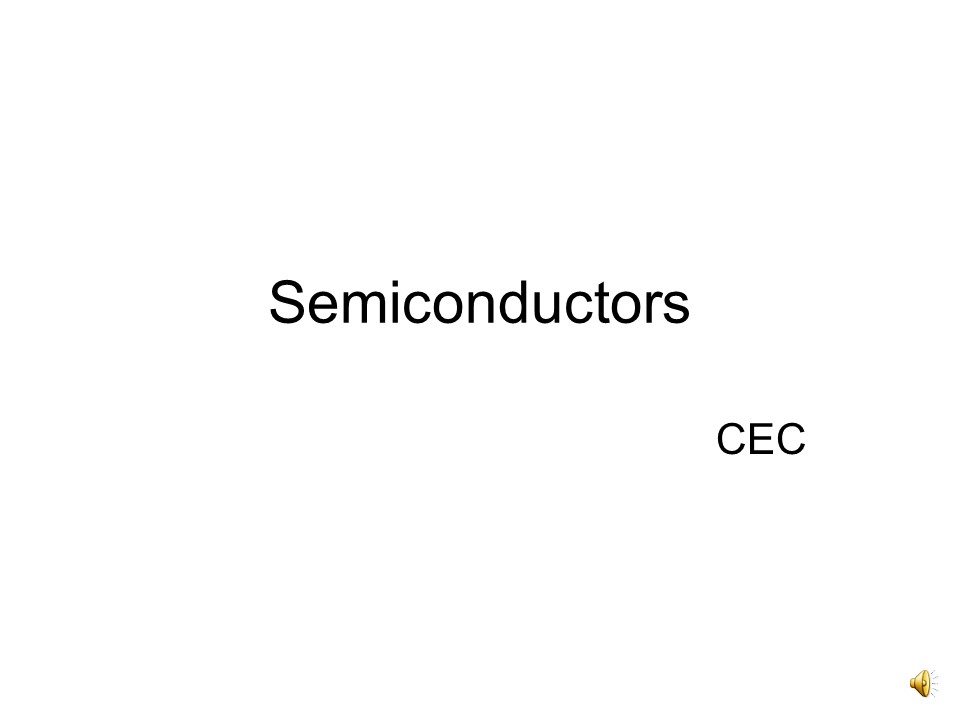Semiconductors - PowerPoint PPT Presentation
Title:
Semiconductors
Description:
The attached narrated power point presentation attempts to explore the construction and working of different types of semiconductor materials. – PowerPoint PPT presentation
Number of Views:37
Title: Semiconductors
1
Semiconductors
- CEC
2
Contents
- Definitions.
- Energy Band Diagrams.
- Intrinsic Semiconductors.
- Extrinsic Semiconductors.
- Comparison.
- PN Junction.
- PN Junction Applications.
3
Definitions
- Energy Band The range of energies possessed by
an electron in a solid. - Valence Electron Electrons in the outermost
orbit of an atom. - Valence Band Range of energies possessed by
valence band electrons. - Conduction Band Range of energies possessed by
free electrons.
4
Definitions
- Fermi Level
- - highest energy level that an electron can
- occupy at the absolute zero temperature.
- - lies between valence and conduction
- bands at absolute zero temperature.
- - tends to change as solids are warmed.
- - value of Fermi level at absolute zero
- temperature known as Fermi energy.
5
Definitions
- Forbidden Energy Gap
- - gap between valence band and
- conduction band.
- - electron can be moved from valence
- band to conduction band by applying
- energy more than forbidden energy
- gap.
- Hole absence of an electron, ve charge.
6
Energy Band Concept
6 eV
1.1 eV/0.72 eV
7
Fermi Level in Solids
Top of the collection of electron energy levels
at absolute zero temperature.
8
Semiconductors
- Resistivity 10-5 to 106 Om.
- Conductivity 105 to 10-6 mho/m.
- Temperature coefficient of resistance Negative.
- Current Flow Due to electrons and holes.
- Materials Silicon, Germanium, Gallium Arsenide.
9
Semiconductor Types
10
Comparison
11
Doping
12
Doped Semiconductors
13
Intrinsic Semiconductors
14
Intrinsic Semiconductors
15
Fermi Level
16
17
18
Compound Semiconductor- Gallium Arsenide
Face Centered Cubic Structure (FCC)
19
Compound Semiconductors
Gallium Arsenide Crystal Structure
20
PN Junction
Holes
Electrons
Concentration gradient causes carriers to move to
the other side of the junction.
Junction
Immobile ions
Potential Barrier opposes carrier movement.
Depletion Region Forward bias reduces the width,
reverse bias increases the width.
VB 0.7 V for Si. 0.3 V for Ge.
21
Biasing a PN Junction
- Forward Bias Positive terminal of the battery
connected to the P - type material, negative
terminal of the battery connected to N - type
material. - Current flow during forward bias.
- Reverse Bias Positive terminal of the battery
connected to the N - type material, negative
terminal of the battery connected to P - type
material. - No current flow during reverse bias.
22
Biased PN Junctions
23
24
Comparison
25
Applications of PN Junction
- Elementary building blocks of active
(semiconductor) electronic components or devices. - Semiconductor Diode One PN Junction.
- Bipolar Junction Transistor Two PN Junctions.
- Thyristors Multiple PN Junctions.
- Schottky Junction metal semiconductor
junction, metal replaces an extrinsic
semiconductor material.
26
Applications of PN Junction
- Light Sources Light Emitting Diodes (LEDs) and
Laser Diodes. - Photodetectors PN Junction Photodiode, PIN
Photodiode, Avalanche Photodiode etc.
LED
Photodiodes
27
Transistor
Two PN Junctions
28
Silicon Controlled Rectifier
Three PN Junctions
29
Light Emitting Diode
30
Photodiodes
PN Junction Photodiode
PIN Photodiode
31
Schottky Junction
Metal Semiconductor Junction
32
Thank You































